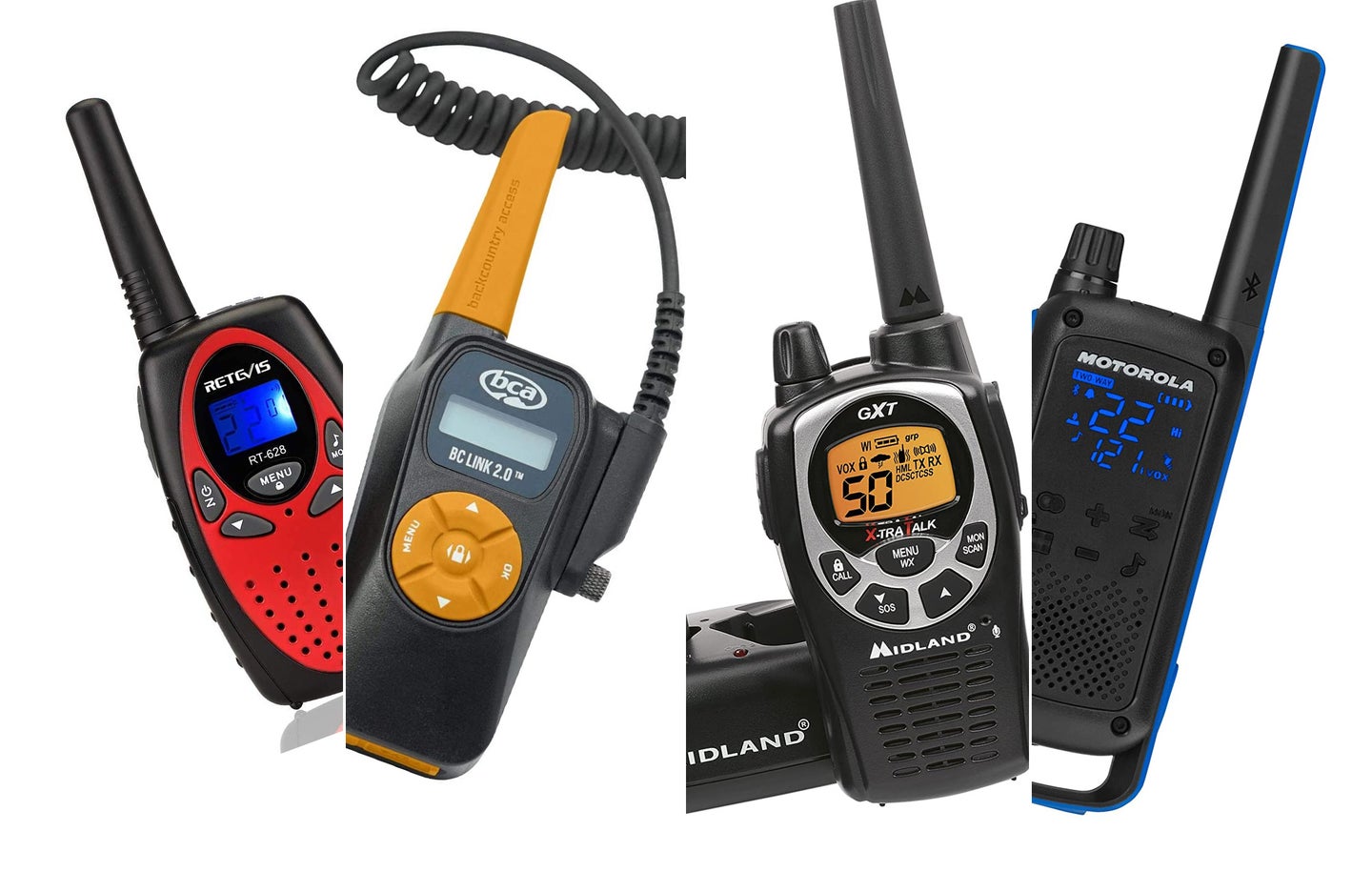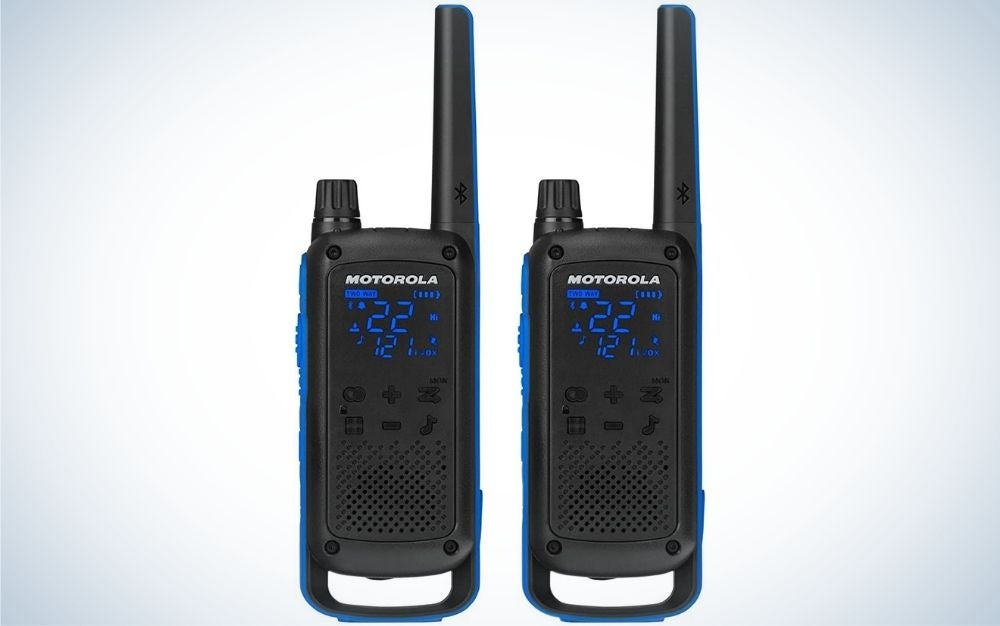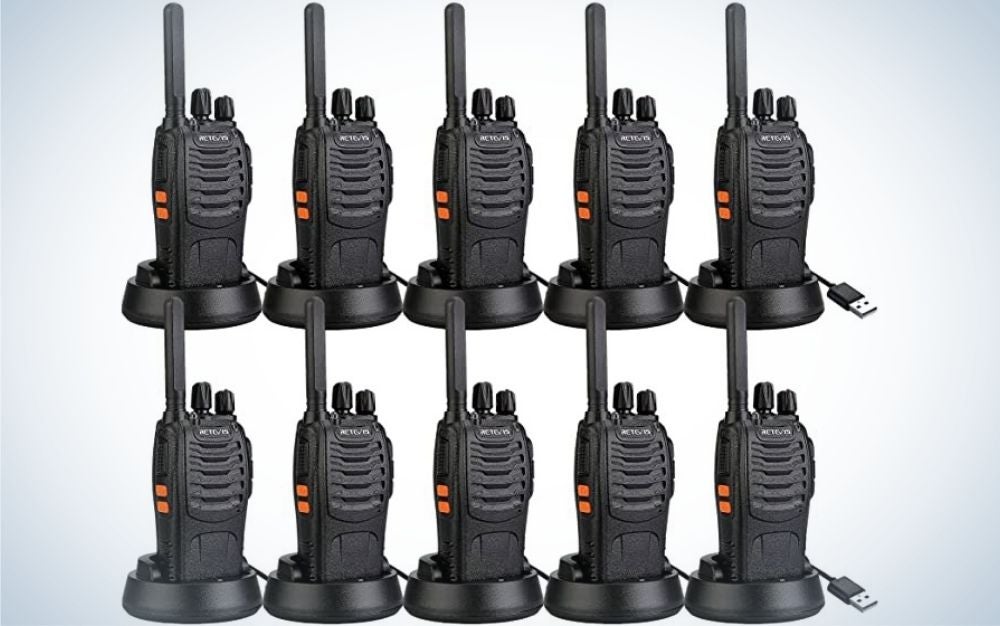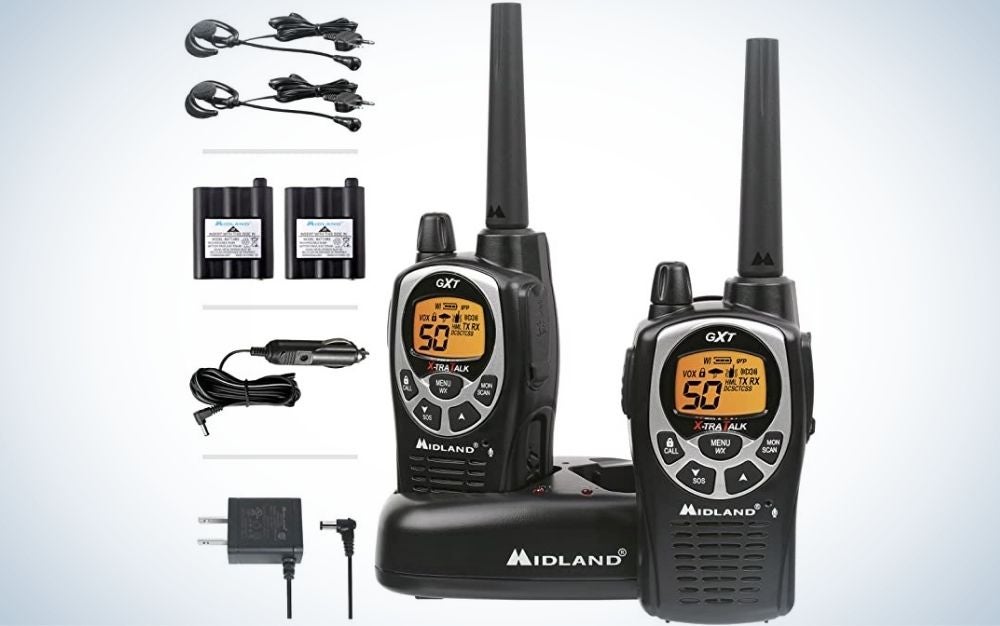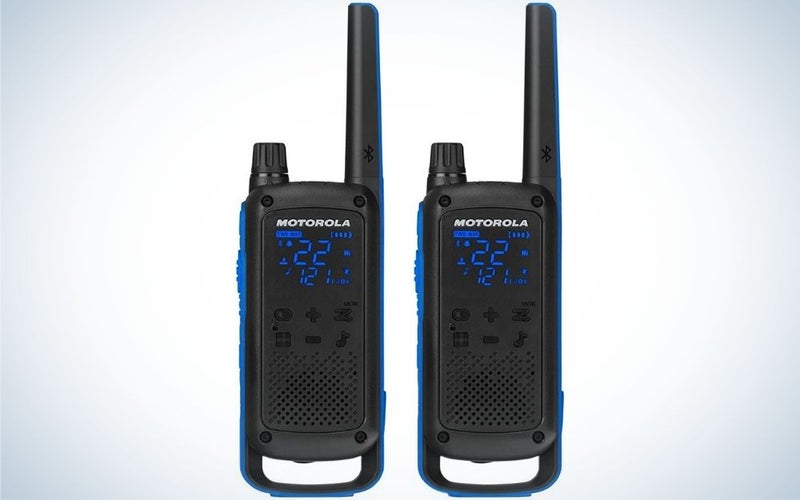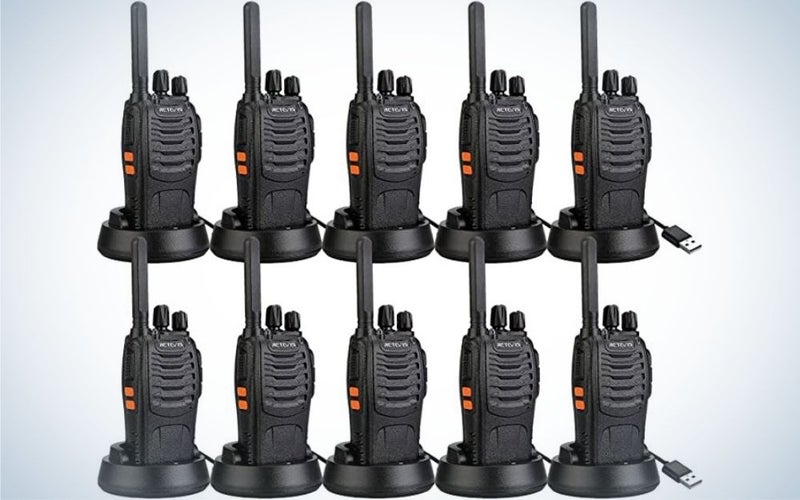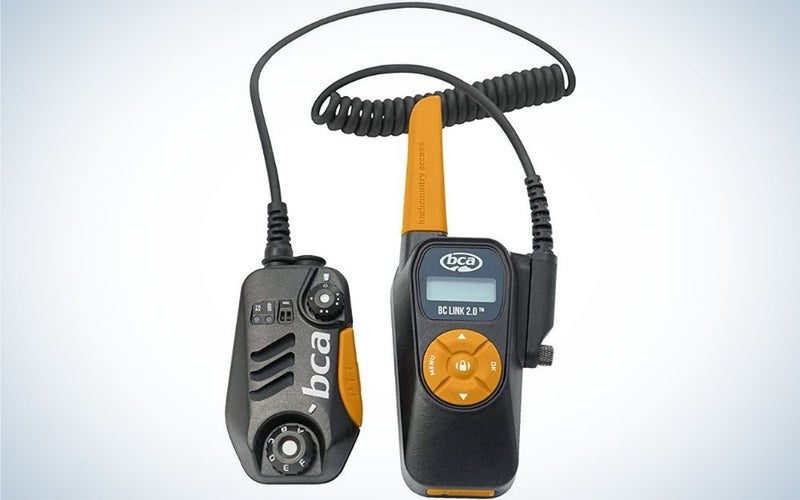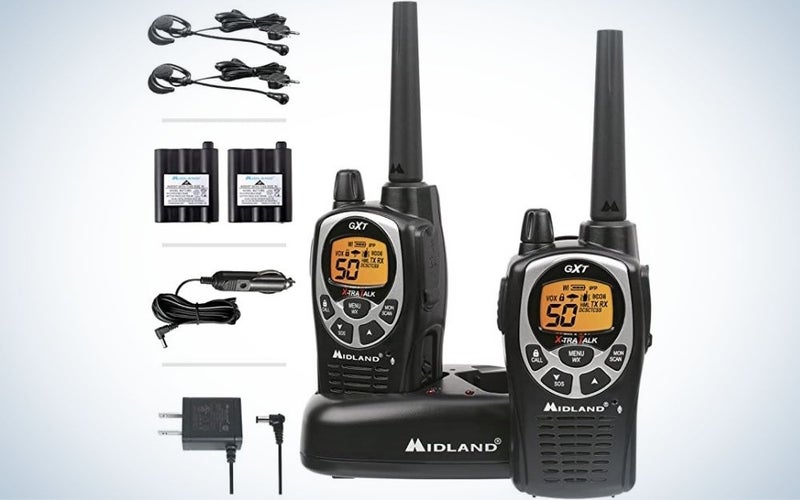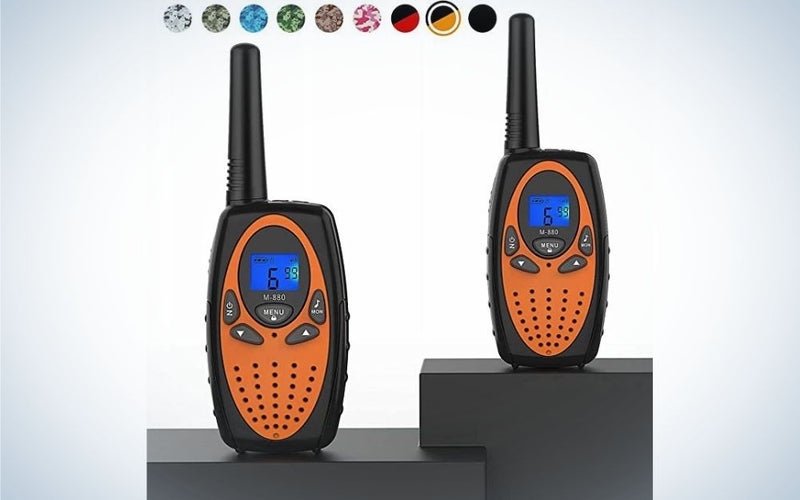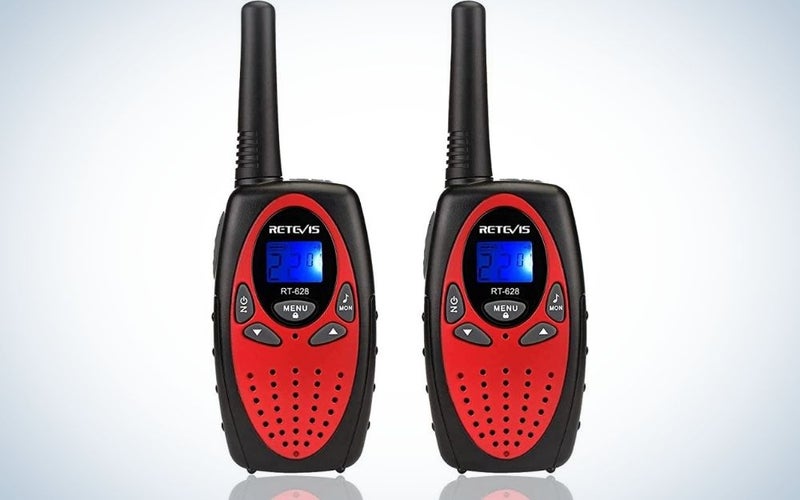We may earn revenue from the products available on this page and participate in affiliate programs. Learn more ›
Even if you have a cellphone, there are still plenty of opportunities for a good walkie talkie in your life. Maybe you’re someone who likes to go outside hiking and camping and wants to stay in touch with your group outside of cell service, you work in a busy warehouse or restaurant where communication is key, or you just like the ease of one button communication. They can also come in handy on film sets and other production environments where quick comms are key. Whatever the reason, getting the best walkie talkies can quickly and easily improve your communication, and it doesn’t hurt that no matter who you are using them is just fun.
- Best overall: Motorola Talkabout T800
- Best for professionals: Retevis H-777
- Best for mountains: Backcountry Access BC Link 2.0
- Best value: Midland GXT1000VP4
- Best for beginners: Topsung M880 FRS
- Best for kids: Retevis RT628
How we chose the best walkie talkies
I just went through the process of walkie talkie research and purchase before a cycling trip through Death Valley where I wanted to be able to talk to friends in a support car.
Our process considered a wide range of products from a number of reputable manufacturers. We scoured the web for professional reviews, reader feedback, and spec comparisons to go along with personal experience and knowledge. We focused on models that offer rugged build quality, high-fidelity sound, and reliable connectivity. We also considered elements like battery life and additional features.
The best walkie talkies: Reviews & Recommendations
With the crucial features and specs out of the way, it’s time to get into our list of the best walkie talkies. While we have split these up into individual awards for specific users, there’s also a lot of overlap when it comes to functionality and usability. So, be sure to check the entire list before committing to any one model.
Best overall: Motorola Talkabout T800
Motorola Solutions
Why it made the cut: A solid combination of features and price make these a solid all-around choice for a wide variety of users.
Specs:
- Channels: 22
- Range: Up to 35 Miles
- Waterproof: IPX4 Water resistant
- Battery Style: AA or included rechargeable battery
- Battery Life: Up 14 hours rechargeable
- Weight: 7.5 oz
Pros
- Streamlined, elegant design
- Easy to use buttons, even in the dark
- Data/messaging Transmission
- Battery flexibility
Cons
- Not waterproof
- Actual range may not meet projections
- Weight
The T800 is a powerful, feature-laden walkie talkie that is often available in a pair for under $100. We love the flexibility to use the included rechargeable batteries or to supplement with just 2 AA batteries. This gives both the environmental advantage, and a lightweight backup plan.
This model is well-regarded for its streamlined design and easy-to-use buttons. It’s not fully waterproof, which isn’t surprising at this price point, but with the included NOAA emergency weather channel and alerts you’ll be able to know if any big storm is coming through, and keep your electronics out of the elements.
What truly sets the T800 apart, though, is the Motorola app that you can run on your phone to pair with the T800. With the T800 and a phone with the app pre-downloaded, you can send GPS location between walkie talkies, even when you are not in the range of a cell tower. The app also lets you track the other T800s in your group on a map and send text messages between them and their apps. Of course, you’ll need an accompanying smartphone to get value out of all of these features.
Its reasonable price and broad feature set make this a winner for a wide variety of users.
Best for professionals: Retevis H-777
Retevis
Why it made the cut: This is a great solution for groups looking to stay in touch on a regular basis of a shorter distance.
Specs:
- Channels: 16
- Range: 2.5 miles
- Waterproof: No
- Battery Style: Rechargeable
- Battery Life: 12 hours
- Weight: 5.5 oz
Pros
- Affordable communication for large groups
- Built in flashlight
- Good sound quality within range
Cons
- Limited range
- Build quality
- Not water or weatherproof.
If you’re trying to communicate with many disparate groups or individuals, like across a camp or construction site, these Retevis walkie talkies are an affordable option. This is a no frills radio that saves cost by avoiding a light up screen and instead relies on two simple knobs for channel and volume control.
The walkie talkies are relatively light and compact but their limited range means you won’t want to use them in challenging outdoor circumstances, but they’re great for more urban environments like restaurants or theaters. The included rechargeable batteries work all day and recharge easily by USB when placed in the included docks.
Some users complained about long term durability, and depending on the environments you are working in, you may want to find something that is fully waterproof. These come equipped with a small light, which could come in handy in a pinch.
Best for mountains: Backcountry Access BC Link 2.0
Backcountry Access
Why it made the cut: These rugged radios can endure serious punishment without failing.
Specs:
- Channels: 22
- Range: 40 miles
- Waterproof: IP56 Water Resistant
- Battery Style: Rechargeable
- Battery Life: 22 Hours
- Weight: 11 oz
Pros
- Durability in extreme environments
- Impressive range
- Included handset
Cons
- Expensive
- Heavy
If you’re heading outside, not just for a hike, but high adventure activities like climbing, ski touring, or mountaineering, you’ll want a walkie talkie like this.
This walkie talkie can endure the outdoors. It’s so robust, in fact, that many users found it exceedingly heavy and a bit cumbersome. Thankfully you can store the radio in your bag and use an external handset clipped to a strap to listen and talk to others on your channel.
If the weather gets messy, like a big snow storm, the Backcountry Access has good water resistance and an interface that is simple to use, even in gloved hands, thanks to dial for volume and channel, large, simple, buttons.
Many users appreciated the strong signal and impressive range that were capable of maintaining a clear signal in bad weather across a big distance, even up and down mountain faces. And if you’re out there for a long day, the extremely impressive battery life will have the radio going with you the whole time.
Of course, all this comes at a cost, not only the hefty 11 oz, but the price tag as well. Especially when you consider that this radio is sold not in pairs, but individually. But when you need a communication beast for a beast of a day, this is what should be at your side.
Best value: Midland GXT1000VP4
Midland
Why it made the cut: They offer a long range and solid features for less money than you might expect.
Specs:
- Channels: 50
- Range: 36 miles
- Waterproof: JIS4 waterproof
- Battery Style: Rechargeable or AA
- Battery Life: 9 hours rechargeable battery
- Weight: 4.8 oz
Pros
- Good range
- NOAA weather alert notifications
- Bright LCD
Cons
- “Waterproof” a loose term
- Can be overwhelmed by features
This midland radio is for the person who wants good performance and range, and access to a whole bunch of features. If you want simple, elegant operation, this is a great choice.
Their impressive range and number of channels, especially for the price, make them a great option for those working in large open outdoor areas, or during outdoor emergencies. If you are coordinating with a large group of many users, you can even program different call tones so you know who in your group is calling.
These are a handy tool, but not just for communication. They also have NOAA alerts for severe weather, SOS siren alerts, and locator signals. While we love the features, navigating through them can get cumbersome.
The waterproofing rating comes from the Japan industrial Standards scale so it might not be as waterproof as you think. While it will work if it is splashed with water, don’t submerge it in liquid and expect it to keep communicating.
Best emergency prep: Topsung M880 FRS
Topsung
Why it made the cut: Get basic features and a three-mile range with very little fuss.
- Channels: 22
- Range: 3 miles
- Waterproof: No
- Battery Style: Three AA batteries
- Battery Life: Battery dependent
- Weight: 2.9 oz
Pros
- Affordable
- LCD Screen for night use
- LIghtweight and small
Cons
- Cheap feeling construction
- Limited Range
- Battery type and number
This walkie talkie is beloved in online stores where customers laud its affordable price and simple operation.
The range is limited, but for situations just out of earshot, like in different rooms within the same building or in a caravan of cars, they work well.
The operation is simple, though many complain that it is tough to understand the instruction manual. Once you figure it out though, it’s hard to forget. The interface relies on easy to push buttons and an easy to read screen, thanks to a light up LCD. AA batteries, and three of them, makes it great as a backup communication device that you can use occasionally and store with fresh batteries.
This is not the radio for pushing the limits or communication over large distances. It’s a cheap solution for communicating with someone just out of earshot.
Best for kids: Retevis RT628
Retevis
Why it made the cut: They’re simple and cheap enough that it won’t hurt when one breaks or gets lost.
- Channels: 22
- Range: 1 mile
- Waterproof: No
- Battery Style: AA
- Battery Life: Battery dependent
- Weight: 3.25 oz
Pros
- Multiple colors
- Price
- Channel lock to stay on the same channel
Cons
- Battery style
- Range
- Durability
Not only is this walkie talkie set exceedingly affordable, but the buttons and walkie talkie body are small and lightweight to fit well in a child’s hands.
Parents will love the channel lock features, which helps keep the radio on the right frequency and from moving onto the wrong channel after fumbling from children’s hands. They’ll also love the price point, which won’t have you pulling your hair out if one of the walkie talkies disappears in the backyard or under a car seat.
The range is just over a mile and is really best for recreation or when the stakes are low, like communication from one side of the neighborhood to the other. Because of this, it is really closer to a toy than a major communication device.
What to consider when shopping for the best walkie talkies
Though many of the best walkie talkie models offer similar bodies or shapes, the internal technology be far different. Knowing how you will use your walkie talkies, where you’ll be, and how long you need them to work will help lead you to the system that will fit you best. Here are a few things to consider, and measurables to look for while you’re shopping.
Price
No matter what you’re buying, price is a good marker of how serious the tool is, and how long you hope to use it for. Knowing how you’re going to use your walkie talkies will help you save money in the right ways. Know what you need, and only by as much as is required to comfortably meet that need.
It’s worth investing in a stronger walkie talkie if you are relying on it to save your life, rather than just trying to avoid running up and down the stairs to tell your spouse which breaker turns off the lights in the kitchen.
Battery and battery life
You’ll have to decide whether you want a model that relies on a rechargeable battery or disposable cells that need replacing once they’re spent. Often rechargeable models will be more expensive, but they do come with the added benefit of creating less waste and not requiring sometimes expensive disposable batteries.
If you need your walkie talkies to work for many days away from civilization, disposable batteries can give you the option of bringing a lightweight backup charge.
While it is often possible to find accurate battery life estimates for rechargeable batteries, battery life for AA or AAA powered walkie talkies can be much more difficult as these batteries are not all created equally. If you do rely on disposables, opt for the higher-end models from reputable brands if you want them to last.
Range
Range determines how far the walkie talkies can communicate with each other. The power of consumer level, or Family Radio Service, walkie talkies is limited, which means you won’t be talking across scores of miles like you might with more professional radio that requires a license. While manufacturers can give you a sense of range, all radios will be affected by things like topography and weather.
The models on this list can communicate with a maximum range of just 1 mile up to nearly 50 miles, so be sure to get something that covers the distance you need.
Channels
Channels are like different rooms along the radio wave that you can pop into for a more private conversation. The more channels you have access to, the more likely you are to find a channel that no one outside of your party is using. This will help you communicate more relatively privately without being interrupted by strangers.
Similarly, having multiple channels means you can switch channels on your radio to communicate with different members of your party if you are trying to keep communication less cluttered with fewer people on the same line.
Durability and weatherproofing
Some walkie talkies are better suited to harsh elements like rain, sea water, and big falls than others. Determine whether yours is going to live in the car, at home, or in more robust outdoor environments that will require better protection.
If you don’t need fully waterproof, don’t spend the money on it. But if you suspect there is a good chance you could drop a walkie talkie in the water, especially in a moment where you might need it most, don’t settle for water resistance.
Features
Are you looking for simple one-button communication? Or do you need a more robust survival tool with other reception and transmission capabilities? Some walkie talkies come with weather alert radios, SOS features, and even data transmission. All of which can be extremely useful, or annoying if they just get in the way.
FAQs
Q: How far can walkie talkies reach?
Typical walkie talkies like those on this list will cover up to roughly 50 miles of range. Of course, that range can vary depending on your specific conditions and location. If you’re trying to send a signal through a mountain or a bunch of buildings in a city setting, that range could shrink significantly.
Q: What’s the difference between walkie talkies and marine radios?
Marine walkie talkies, or VHF radios work great, especially with low energy over long distances, but they are only allowed on the water. In most cases it is actually illegal to use them on land. If you’ll be on the open water, interacting with large commercial vessels, check your local laws, and invest in a marine radio, and if you have one already, leave it in the boat and buy a walkie talkie for hiking.
Q: Do you need a license for walkie talkies?
If you’re looking to upgrade from walkie talkies, there are a few options, like General Mobile Radio Service (GMRS) which require an FCC license, or Citizens Band Radio Service (CB) which have dedicated rules for operation as defined by the FCC. When upgrading, be sure to know how your radio works, what guidelines it falls under, and that you are following all laws and licensing regulations as the penalties can be fines and even imprisonment.
Final thoughts on the best walkie talkies
- Best overall: Motorola Talkabout T800
- Best for professionals: Retevis H-777
- Best for mountains: Backcountry Access BC Link 2.0
- Best value: Midland GXT1000VP4
- Best for beginners: Topsung M880 FRS
- Best for kids: Retevis RT628
Walkie talkies are an incredible tool, and a whole lot of fun. Knowing what you need out of them and how often you’ll use them will help you get the one you need. Be it simple and clear communication, or cutting-edge tech and information. The walkie talkie can be as simple or modern as you like, but whatever you choose, have fun, and be safe.
Why trust us
PopPhoto has a long history of delivering the opinions of some of the sharpest and most prolific camera dorks the world has to offer. Since 1937, we’ve been reviewing cameras, providing wisdom from well-known photographers, and generally just nerding out about all that goes into making great pictures. Our current crop of writers and editors have decades of professional photography and camera writing experience among them. Collectively, we’ve probably shot with just about every camera and lens combo you can imagine—as well as some obscure stuff you may not even know about. Remember the Casio Tryx folding camera? PopPhoto does.
We also get that buying a camera is a big decision, which is why we’re dedicated to helping folks choose the right one (or, in our case “ones”) for their needs. Case in point: Handing over top dollar for an expensive rig may leave you unsatisfied if it doesn’t fit your preferred shooting style. Sure, a $6,000 sports-oriented DSLR can capture landscapes, but do you really need to do it at 30 frames-per-second? No, you don’t.
Related: Best camera phones
